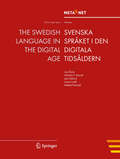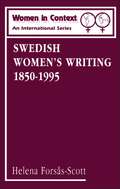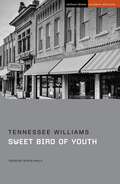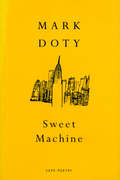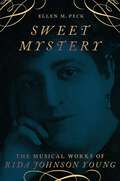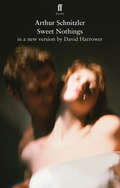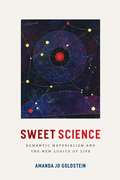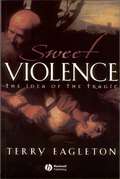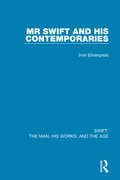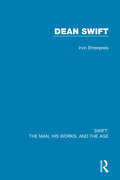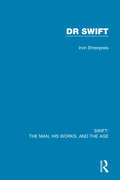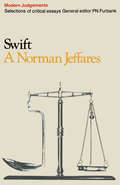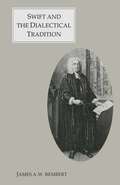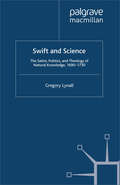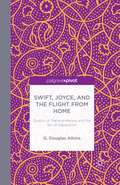- Table View
- List View
The Swedish Language in the Digital Age (White Paper Series)
by Georg Rehm Hans UszkoreitThis white paper is part of a series that promotes knowledge about language technology and its potential. It addresses educators, journalists, politicians, language communities and others. The availability and use of language technology in Europe varies between languages. Consequently, the actions that are required to further support research and development of language technologies also differ for each language. The required actions depend on many factors, such as the complexity of a given language and the size of its community. META-NET, a Network of Excellence funded by the European Commission, has conducted an analysis of current language resources and technologies. This analysis focused on the 23 official European languages as well as other important national and regional languages in Europe. The results of this analysis suggest that there are many significant research gaps for each language. A more detailed expert analysis and assessment of the current situation will help maximise the impact of additional research and minimize any risks. META-NET consists of 54 research centres from 33 countries that are working with stakeholders from commercial businesses, government agencies, industry, research organisations, software companies, technology providers and European universities. Together, they are creating a common technology vision while developing a strategic research agenda that shows how language technology applications can address any research gaps by 2020.
Swedish Women's Writing 1850-1995 (Women in Context: Women's Writing)
by Helena Forsas-ScottProvides a survey of women's writing in Sweden, from the beginnings of the struggle for emancipation in the 1850s to the present day. These writers are seen within the political, cultural and economic context of women's lives. Modern critical currents are also assessed and Swedish feminist criticism is considered alongside the French and American traditions.
Sweet Bird of Youth (Student Editions)
by Tennessee Williams'Tennessee Williams's mordantly funny and deeply troubled meditation on the desperate dismay of ageing and the iniquities of racial bigotry.' INDEPENDENT 'It's a wonderfully weird play, starting claustrophobic, losing intensity as it introduces the locals… then regrouping for a devastating second half… This unruly, unforgettable play takes its unpredictable course to something that makes you feel afresh our powerlessness against time.' THE TIMES When Chance Wayne left the small town of St. Cloud, he did so with the ambition of being an actor: now, many years later, he returns as a gigolo and the companion of faded movie star Alexandra del Lago. But can Chance convince the town he did actually make it big and win over his childhood sweetheart? Or will the mistakes of his past punish him still? Sweet Bird of Youth is Tennessee Williams's 1959 Broadway hit that explores the social and political climate of 1950s America, at a time when sexual freedom was a critical issue. This edition includes an introduction by Alison Walls that explores the play's production history as well as the dramatic, thematic and academic debates that surround it.
Sweet Bird of Youth (Student Editions)
by Tennessee Williams'Tennessee Williams's mordantly funny and deeply troubled meditation on the desperate dismay of ageing and the iniquities of racial bigotry.' INDEPENDENT 'It's a wonderfully weird play, starting claustrophobic, losing intensity as it introduces the locals… then regrouping for a devastating second half… This unruly, unforgettable play takes its unpredictable course to something that makes you feel afresh our powerlessness against time.' THE TIMES When Chance Wayne left the small town of St. Cloud, he did so with the ambition of being an actor: now, many years later, he returns as a gigolo and the companion of faded movie star Alexandra del Lago. But can Chance convince the town he did actually make it big and win over his childhood sweetheart? Or will the mistakes of his past punish him still? Sweet Bird of Youth is Tennessee Williams's 1959 Broadway hit that explores the social and political climate of 1950s America, at a time when sexual freedom was a critical issue. This edition includes an introduction by Alison Walls that explores the play's production history as well as the dramatic, thematic and academic debates that surround it.
Sweet Machine: Poems (Cape Poetry Ser.)
by Mark DotyThe three books that brought Mark Doty acclaim - the poetry collections My Alexandria and Atlantis, and the prose memoir Heaven's Coast - dealt unflinchingly with love and its loss. The poems in this new book are from a man transfigured and elevated by grief, and the tone throughout is one of celebration at the majesty, the impossible splendour of the living world. Whether the subject is golden retrievers or humpback whales, Delft tiles or Murano glass, lilacs on Third Avenue or turtles on Broadway, these are exquisite, transcendent hymns of praise: sensuous, brilliant and thrillingly alive.
Sweet Mystery: The Musical Works of Rida Johnson Young (Broadway Legacies)
by Ellen M. PeckRida Johnson Young (ca. 1869-1926) was one of the most prolific female playwrights of her time, as well as a lyricist and librettist in the musical theater. She wrote more than thirty full-length plays, operettas, and musical comedies, 500 songs, and four novels, including Naughty Marietta, Lady Luxury, The Red Petticoat, and When Love is Young . Despite her extensive output, no significant study of her work has been produced. This book looks at her musical theater works with in-depth analyses of her librettos and lyrics, as well as her working relationships with other writers, performers, and producers, particularly Lee and J. J. Shubert. Using archival materials such as original typescripts, correspondence, and reviews, the book contextualizes her work in the early twentieth century professional theater and provides a window into the standard practices of writing and production of the era.
Sweet Mystery: The Musical Works of Rida Johnson Young (Broadway Legacies)
by Ellen M. PeckRida Johnson Young (ca. 1869-1926) was one of the most prolific female playwrights of her time, as well as a lyricist and librettist in the musical theater. She wrote more than thirty full-length plays, operettas, and musical comedies, 500 songs, and four novels, including Naughty Marietta, Lady Luxury, The Red Petticoat, and When Love is Young . Despite her extensive output, no significant study of her work has been produced. This book looks at her musical theater works with in-depth analyses of her librettos and lyrics, as well as her working relationships with other writers, performers, and producers, particularly Lee and J. J. Shubert. Using archival materials such as original typescripts, correspondence, and reviews, the book contextualizes her work in the early twentieth century professional theater and provides a window into the standard practices of writing and production of the era.
Sweet Nothings
by David HarrowerA young man has an affair with a married woman. He is terrified her husband will challenge him to a duel and kill him. Meanwhile he toys with the affections of another and, for a moment, life seems full of joy. The doorbell rings. The husband enters the room. Based on Schnitzler's play Liebelei, David Harrower's Sweet Nothings captures the power of sexual longing, the cruelty of tradition and the vulnerability of those in love. The play premieres at the Young Vic, London, in March 2010.'I write of love and death. What other subjects are there?'Arthur Schnitzler.
Sweet Science: Romantic Materialism and the New Logics of Life
by Amanda Jo GoldsteinToday we do not expect poems to carry scientifically valid information. But it was not always so. In Sweet Science, Amanda Jo Goldstein returns to the beginnings of the division of labor between literature and science to recover a tradition of Romantic life writing for which poetry was a privileged technique of empirical inquiry. Goldstein puts apparently literary projects, such as William Blake’s poetry of embryogenesis, Goethe’s journals On Morphology, and Percy Shelley’s “poetry of life,” back into conversation with the openly poetic life sciences of Erasmus Darwin, J. G. Herder, Jean-Baptiste Lamarck, and Étienne Geoffroy Saint-Hilaire. Such poetic sciences, Goldstein argues, share in reviving Lucretius’s De rerum natura to advance a view of biological life as neither self-organized nor autonomous, but rather dependent on the collaborative and symbolic processes that give it viable and recognizable form. They summon De rerum natura for a logic of life resistant to the vitalist stress on self-authorizing power and to make a monumental case for poetry’s role in the perception and communication of empirical realities. The first dedicated study of this mortal and materialist dimension of Romantic biopoetics, Sweet Science opens a through-line between Enlightenment materialisms of nature and Marx’s coming historical materialism.
Sweet Science: Romantic Materialism and the New Logics of Life
by Amanda Jo GoldsteinToday we do not expect poems to carry scientifically valid information. But it was not always so. In Sweet Science, Amanda Jo Goldstein returns to the beginnings of the division of labor between literature and science to recover a tradition of Romantic life writing for which poetry was a privileged technique of empirical inquiry. Goldstein puts apparently literary projects, such as William Blake’s poetry of embryogenesis, Goethe’s journals On Morphology, and Percy Shelley’s “poetry of life,” back into conversation with the openly poetic life sciences of Erasmus Darwin, J. G. Herder, Jean-Baptiste Lamarck, and Étienne Geoffroy Saint-Hilaire. Such poetic sciences, Goldstein argues, share in reviving Lucretius’s De rerum natura to advance a view of biological life as neither self-organized nor autonomous, but rather dependent on the collaborative and symbolic processes that give it viable and recognizable form. They summon De rerum natura for a logic of life resistant to the vitalist stress on self-authorizing power and to make a monumental case for poetry’s role in the perception and communication of empirical realities. The first dedicated study of this mortal and materialist dimension of Romantic biopoetics, Sweet Science opens a through-line between Enlightenment materialisms of nature and Marx’s coming historical materialism.
Sweet Science: Romantic Materialism and the New Logics of Life
by Amanda Jo GoldsteinToday we do not expect poems to carry scientifically valid information. But it was not always so. In Sweet Science, Amanda Jo Goldstein returns to the beginnings of the division of labor between literature and science to recover a tradition of Romantic life writing for which poetry was a privileged technique of empirical inquiry. Goldstein puts apparently literary projects, such as William Blake’s poetry of embryogenesis, Goethe’s journals On Morphology, and Percy Shelley’s “poetry of life,” back into conversation with the openly poetic life sciences of Erasmus Darwin, J. G. Herder, Jean-Baptiste Lamarck, and Étienne Geoffroy Saint-Hilaire. Such poetic sciences, Goldstein argues, share in reviving Lucretius’s De rerum natura to advance a view of biological life as neither self-organized nor autonomous, but rather dependent on the collaborative and symbolic processes that give it viable and recognizable form. They summon De rerum natura for a logic of life resistant to the vitalist stress on self-authorizing power and to make a monumental case for poetry’s role in the perception and communication of empirical realities. The first dedicated study of this mortal and materialist dimension of Romantic biopoetics, Sweet Science opens a through-line between Enlightenment materialisms of nature and Marx’s coming historical materialism.
Sweet Science: Romantic Materialism and the New Logics of Life
by Amanda Jo GoldsteinToday we do not expect poems to carry scientifically valid information. But it was not always so. In Sweet Science, Amanda Jo Goldstein returns to the beginnings of the division of labor between literature and science to recover a tradition of Romantic life writing for which poetry was a privileged technique of empirical inquiry. Goldstein puts apparently literary projects, such as William Blake’s poetry of embryogenesis, Goethe’s journals On Morphology, and Percy Shelley’s “poetry of life,” back into conversation with the openly poetic life sciences of Erasmus Darwin, J. G. Herder, Jean-Baptiste Lamarck, and Étienne Geoffroy Saint-Hilaire. Such poetic sciences, Goldstein argues, share in reviving Lucretius’s De rerum natura to advance a view of biological life as neither self-organized nor autonomous, but rather dependent on the collaborative and symbolic processes that give it viable and recognizable form. They summon De rerum natura for a logic of life resistant to the vitalist stress on self-authorizing power and to make a monumental case for poetry’s role in the perception and communication of empirical realities. The first dedicated study of this mortal and materialist dimension of Romantic biopoetics, Sweet Science opens a through-line between Enlightenment materialisms of nature and Marx’s coming historical materialism.
Sweet Science: Romantic Materialism and the New Logics of Life
by Amanda Jo GoldsteinToday we do not expect poems to carry scientifically valid information. But it was not always so. In Sweet Science, Amanda Jo Goldstein returns to the beginnings of the division of labor between literature and science to recover a tradition of Romantic life writing for which poetry was a privileged technique of empirical inquiry. Goldstein puts apparently literary projects, such as William Blake’s poetry of embryogenesis, Goethe’s journals On Morphology, and Percy Shelley’s “poetry of life,” back into conversation with the openly poetic life sciences of Erasmus Darwin, J. G. Herder, Jean-Baptiste Lamarck, and Étienne Geoffroy Saint-Hilaire. Such poetic sciences, Goldstein argues, share in reviving Lucretius’s De rerum natura to advance a view of biological life as neither self-organized nor autonomous, but rather dependent on the collaborative and symbolic processes that give it viable and recognizable form. They summon De rerum natura for a logic of life resistant to the vitalist stress on self-authorizing power and to make a monumental case for poetry’s role in the perception and communication of empirical realities. The first dedicated study of this mortal and materialist dimension of Romantic biopoetics, Sweet Science opens a through-line between Enlightenment materialisms of nature and Marx’s coming historical materialism.
Sweet Science: Romantic Materialism and the New Logics of Life
by Amanda Jo GoldsteinToday we do not expect poems to carry scientifically valid information. But it was not always so. In Sweet Science, Amanda Jo Goldstein returns to the beginnings of the division of labor between literature and science to recover a tradition of Romantic life writing for which poetry was a privileged technique of empirical inquiry. Goldstein puts apparently literary projects, such as William Blake’s poetry of embryogenesis, Goethe’s journals On Morphology, and Percy Shelley’s “poetry of life,” back into conversation with the openly poetic life sciences of Erasmus Darwin, J. G. Herder, Jean-Baptiste Lamarck, and Étienne Geoffroy Saint-Hilaire. Such poetic sciences, Goldstein argues, share in reviving Lucretius’s De rerum natura to advance a view of biological life as neither self-organized nor autonomous, but rather dependent on the collaborative and symbolic processes that give it viable and recognizable form. They summon De rerum natura for a logic of life resistant to the vitalist stress on self-authorizing power and to make a monumental case for poetry’s role in the perception and communication of empirical realities. The first dedicated study of this mortal and materialist dimension of Romantic biopoetics, Sweet Science opens a through-line between Enlightenment materialisms of nature and Marx’s coming historical materialism.
Sweet Violence: The Idea of the Tragic
by Terry EagletonTerry Eagleton's Tragedy provides a major critical and analytical account of the concept of 'tragedy' from its origins in the Ancient world right down to the twenty-first century. A major new intellectual endeavour from one of the world's finest, and most controversial, cultural theorists. Provides an analytical account of the concept of 'tragedy' from its origins in the ancient world to the present day. Explores the idea of the 'tragic' across all genres of writing, as well as in philosophy, politics, religion and psychology, and throughout western culture. Considers the psychological, religious and socio-political implications and consequences of our fascination with the tragic.
Swift: Volume One: Mr Swift and his Contemporaries (Swift: The Man, his Works, and the Age)
by Irvin EhrenpreisFirst published in 1962, Mr Swift and his Contemporaries, is the first of three volumes providing a detailed exploration of the events of Swift’s life. This volume is a thorough insight into the historical and social setting of Swift’s life, the evolution of his character, and the composition and interpretation of his works. It includes a wealth of material concerning Swift’s family and career, his emotional and sexual life, his relationship with Sir William Temple, and the design and meaning of both A Tale of a Tub and The Battle of the Books. Mr Swift and his Contemporaries is ideal for anyone with an interest in Swift’s life, work, and the period in which he lived.
Swift: Volume Three: Dean Swift (Swift: The Man, his Works, and the Age)
by Irvin EhrenpreisFirst published in 1983, Dean Swift is the concluding book in a series of three volumes providing a detailed exploration of the events of Swift’s life. The third volume follows Swift’s life and career from 1714 to 1745 and sets it against the public events of the age, paying close attention to political and economic change, ecclesiastical problems, social issues, and literary history. It traces Swift’s rise to becoming first citizen of Ireland and looks in detail at the composition, publication, and reception of Gulliver’s Travels, as well as many of Swift’s other works, both poetry and prose. It also explores Swift’s later years, his love affairs with Esther Johnson and Esther Vanhomrigh, his complicated friendships with Pope, Lord Bolingbroke, and Archbishop King, and his declining health. Dean Swift is a hugely detailed insight into Swift’s life from 1714 until his death and will be of interest to anyone wanting to find out more about his life and works.
Swift: Volume Two: Dr Swift (Swift: The Man, his Works, and the Age)
by Irvin EhrenpreisFirst published in 1967, Dr Swift is the second of three volumes providing a detailed exploration of the events of Swift’s life. This volume begins by assessing Swift’s character, hopes and ambitions in 1699. It then traces his life and career up to 1714 in minute detail, giving close consideration to Swift’s expectations and the extent to which he felt they were fulfilled. In doing so, it covers Swift’s movement between Ireland and England, his reputation as a poet, his historical writing, his church preferments, involvement in politics, and much more, including his relationships with a number of prominent social figures of the time. Dr Swift is ideal for those with an interest in Swift’s life, and in particular his life and career between 1699 and 1714.
Swift: Volume Three: Dean Swift (Swift: The Man, his Works, and the Age)
by Irvin EhrenpreisFirst published in 1983, Dean Swift is the concluding book in a series of three volumes providing a detailed exploration of the events of Swift’s life. The third volume follows Swift’s life and career from 1714 to 1745 and sets it against the public events of the age, paying close attention to political and economic change, ecclesiastical problems, social issues, and literary history. It traces Swift’s rise to becoming first citizen of Ireland and looks in detail at the composition, publication, and reception of Gulliver’s Travels, as well as many of Swift’s other works, both poetry and prose. It also explores Swift’s later years, his love affairs with Esther Johnson and Esther Vanhomrigh, his complicated friendships with Pope, Lord Bolingbroke, and Archbishop King, and his declining health. Dean Swift is a hugely detailed insight into Swift’s life from 1714 until his death and will be of interest to anyone wanting to find out more about his life and works.
Swift: Volume One: Mr Swift and his Contemporaries (Swift: The Man, his Works, and the Age)
by Irvin EhrenpreisFirst published in 1962, Mr Swift and his Contemporaries, is the first of three volumes providing a detailed exploration of the events of Swift’s life. This volume is a thorough insight into the historical and social setting of Swift’s life, the evolution of his character, and the composition and interpretation of his works. It includes a wealth of material concerning Swift’s family and career, his emotional and sexual life, his relationship with Sir William Temple, and the design and meaning of both A Tale of a Tub and The Battle of the Books. Mr Swift and his Contemporaries is ideal for anyone with an interest in Swift’s life, work, and the period in which he lived.
Swift: Volume Two: Dr Swift (Swift: The Man, his Works, and the Age)
by Irvin EhrenpreisFirst published in 1967, Dr Swift is the second of three volumes providing a detailed exploration of the events of Swift’s life. This volume begins by assessing Swift’s character, hopes and ambitions in 1699. It then traces his life and career up to 1714 in minute detail, giving close consideration to Swift’s expectations and the extent to which he felt they were fulfilled. In doing so, it covers Swift’s movement between Ireland and England, his reputation as a poet, his historical writing, his church preferments, involvement in politics, and much more, including his relationships with a number of prominent social figures of the time. Dr Swift is ideal for those with an interest in Swift’s life, and in particular his life and career between 1699 and 1714.
Swift and Science: The Satire, Politics and Theology of Natural Knowledge, 1690-1730
by G. LynallIt is thought that Swift was opposed to the new science that heralded the beginning of the modern age, but this book interrogates that assumption, tracing the theological, political, and socio-cultural resonances of scientific knowledge in the early eighteenth century, and considering what they can reveal about Swift's imagination.
Swift, Joyce, and the Flight from Home: Quests of Transcendence and the Sin of Separation
by G. AtkinsIn a fresh reading of Gulliver's Travels and A Portrait of the Artist as a Young Man, Atkins draws parallels between the protagonists: both Lemuel Gulliver and Stephen Dedalus flee from the burdens of life, seeking a transcendent existence. The study sheds important new light on both novels as essential critiques of modern misunderstandings.
